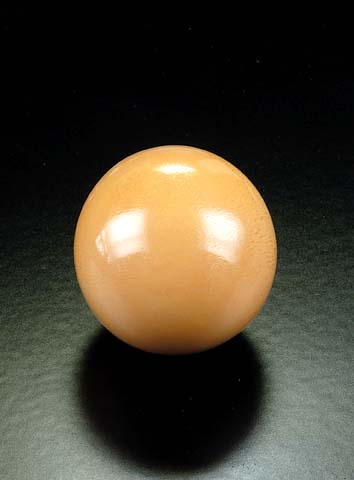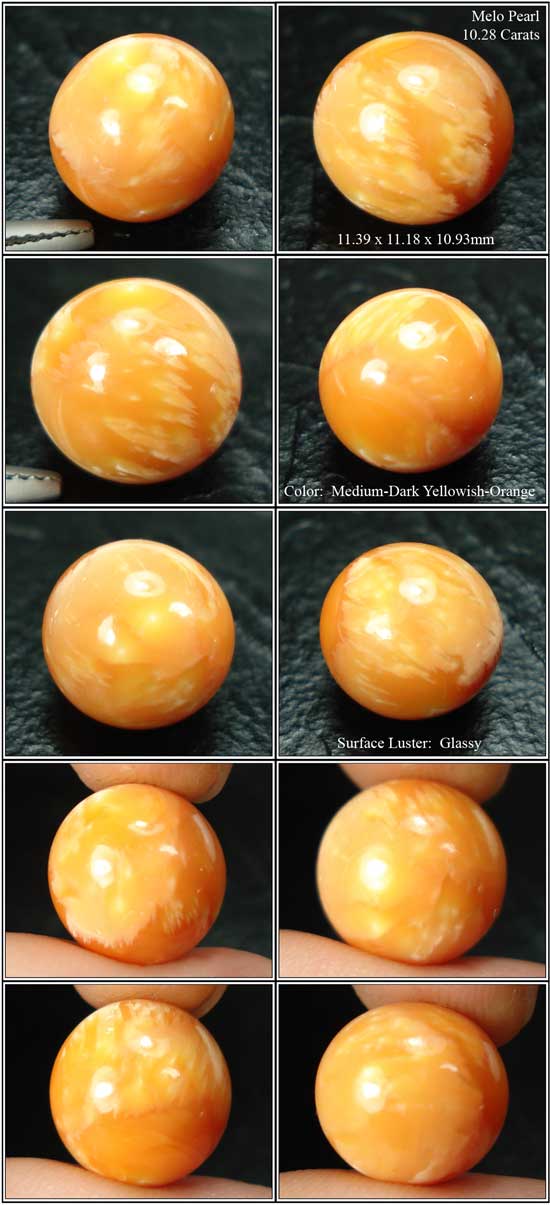Melo Pearls from Myanmar
Melo Pearls from Myanmar
An abstract of a poster session presentation by Jo Ellen Cole
to the International Gemological Symposium 2006
Gemological Institute of America
Han Htun, F.G.A.1, Bill Larson2, Jo Ellen Cole, G.G., F.G.A.3
1 Stalwart Gem Laboratory, Yangon, Myanmar
2 Pala International, Inc., Fallbrook, CA
3 Cole Appraisal Services, Carlsbad, CA
Introduction
Non-nacreous melo pearls are produced by melo volutes, which are found along coastal areas of Myanmar as well as Indonesia, Thailand, Cambodia, and Vietnam. Occurring in a range of colors, the most prized is the intense orange hue commonly found in a ripe papaya. These pearls exhibit a silky flame-like structure and a porcellaneous luster that make them very attractive. Like conch pearls from Strombus gigas, melo pearls are truly rare and have become collector’s items both in the east and the west. However, in Myanmar there is no written literature or historical references regarding melo pearls. Very few people know about them and dealers and collectors in these pearls are equally rare.
 |
| A fine Burmese melo pearl, 133.6 cts., from Pala International. The subtle flame structure visible on the right side of this melo pearl gives the piece a delicate elegance. Price available upon request. |
Description and Habitat of Melo melo gastropods
The species found sporadically along Myanmar coastal areas is Melo melo, a gastropod. They have been known to exist since time immemorial along the Arakan coast and in the southern region of Dawei (Tavoy), the Mergui Archipelago, and Kawthaung in the Andaman Sea near Thailand.
In Myanmar these shells are called “Ohn kayu” (coconut shell), as they resemble coconuts. The orange pearls derived from these volutes are also called “Ohn pale” meaning coconut pearls. The color of these shells varies from orange to orangey-yellow, pale yellow to brownish in color. Their size in length ranges from 120 mm. to 230 mm., although larger sizes have been reported. Melo shells are fished at a depth between 30 meters to 50 meters in a muddy sea bottom by “Wa-lat” or “Gar” fishing trawlers.
 |
| This Burmese melo pearl displays a complex and irregular flame structure found in some pieces. These and the other photographs below were sent by a friend of Pala International in Thailand. |
According to information given by one experienced fisherman, the probability of finding an orange melo pearl is one in several thousand shells, with the size and color of the melo pearl being determined by the size and lip color of the parent mollusk. He reportedly viewed an orange melo pearl about the size and shape of a quail’s egg seven years ago. Many people in this part of the world eat the mollusk by boiling it and if a melo pearl were present this would cause undesirable surface blemishes on the pearl. “Ohn kayu” or melo shells are sometimes used as horns and blown in religious ceremonies and rites. In coastal villages these shells are commonly seen being used as ashtrays for cheroots and cigars. One fisherman told us a story that when they were young and ignorant they actually used to play marble games with spherical melo pearls.
The chemical composition of the melo shell is calcite and aragonite. With a hardness of approximately 5 and a porcellaneous luster near its lip, the shell exhibits a silky flame structure very similar to the pearl itself.
Description and gemology of Myanmar melo pearls
- Formation – Non-nacreous melo pearls are formed when an irritant enters the mantle of a mollusk; it may take several decades to grow a melo pearl of significant size.
- Color – Ranges from intense orange to orange, yellowish-orange, yellow, to almost white. Rare color of reddish-orange has been reported.
- Flame Structure – One of the most attractive features of melo pearls is their fiery flame structure. On some pearl surfaces there is a regular pattern of parallel elongated striations that impart a silky sheen. In some specimens distinct microscopic “flames” can be observed that are actually thin lamellae. The lamellae are almost parallel to one another and when sometimes perpendicular to the axis of the pearl result in a “pseudo-chatoyancy” effect. Pearls with a distinct flame structure have a “watered silk” appearance towards the periphery of the sphere. In cases where a mottled texture of white or brown spots occurs, the flame structure is coarse and difficult to resolve to the unaided eye. These pearls tend to exhibit dimpled surface features.
- Luster – Melo pearls exhibit a porcelain-like luster. Especially when they are repolished, they then impart a very shiny luster like porcelain chinaware; this feature is referred to as “porcellaneous luster.
- Shape – Myanmar melo pearls occur in a variety of shapes, ranging from irregular baroque to oval and egg-shaped. Although generally rounded, near spherical or round shape is very rare.
- Size – The pearls may vary in size from a few mm. to over 32 mm. in diameter. Some pearls over 200 carats have been found from Arakan and the Mergui Archipelago.
- Hardness – Myanmar melo pearls have an approximate hardness of 5 on the Mohs scale.
- Refractive Index – The R.I. varies between 1.51 – 1.64.
- Fluorescence Under Ultraviolet Light – Variable, mostly chalky blue or orange.
- Chemical Composition – The chemical composition of melo pearls contains a mixture of aragonite and calcite.
- Stability to Light – Due to exposure to ultra-violet rays in natural sunlight, both the melo shells and their pearls are known to fade in color. On a trip to Mergui Archipelago the two senior authors had noticed several melo shells that had virtually lost most of their color especially near the lip in regards to the shell. The senior authors have seen a friend in Myeik (Mergui) wearing a ring with a melo pearl which has a very pale whitish-yellow color on the exposed side and on the bottom side still retains its beautiful original orange color. Asked how long he had worn it he answered “five years.” Note: Properties of melo pearls are very similar to conch pearls produced by Strombus gigas.
 |
Marketing
The majority of pearls are fished from the Mergui Archipelago. The town of Myeik (Mergui) is a trading center for these rare pearls, where they are bought and sold discretely. Intense orange color, spherical shape, unique flame structure, and size are all considered in determining the price. Irregular, baroque and button shaped pearls with less prominent flame structure and cloudy white spots of mottled texture command lower prices.
Most melo pearl dealers in Myeik are aware of this unique rare pearl and when they manage to buy some from the local fishermen, most go to Thailand and are sold to the highest bidder. The most senior author has seen only a few that came to his laboratory for testing in Yangon. The majority of pearls marketed in Yangon come from the Arakan coastal region.
Imitation melo pearls have also been seen in various places. They were sawn and rounded or tumbled from the thickest portion of good-color melo shells’ lips. They display a different pattern of flame structure to an experienced eye, which consists of concentric radiating flames and parallel banded layers displaying a distinct “pseudo-chatoyancy” effect.
Conclusion
Although Myanmar is famous for its ruby, sapphire, and jade, no legendary accounts have been written about Melo melo pearls. For centuries the habitat of Melo melo shells has been known to exist along the coastal waters of Myanmar. The Mergui Archipelago has a long stretch of coastal area with over 800 islands. This area also produces some of the finest silver-pink and golden pearls. At pearl island hatcheries, pearls are cultured from bivalve mollusks, Pinctada maxima and Pinctada mertensii.
With its intense orange color, unique flame structure, spherical shape, chatoyancy, porcellaneous luster, and durability, all these features combine to make melo pearl amongst the rarest gems in the world. Since Myanmar coastal areas offer an ideal environment for the habitat of melo gastropods, more exposure and education is necessary to upgrade its market. We are certain many more of these exotic orange pearls will be fished from Myanmar waters in the near future.
 |
For more information regarding melo pearls on Palagems.com, see: